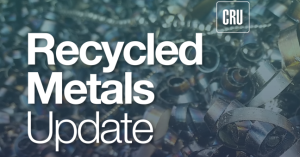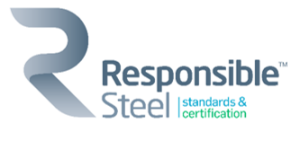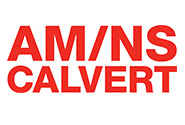
Could we be looking at a weakness in June prices?
The chatter about the June ferrous scrap market has been noticeably muted as we come off the Memorial Day weekend.

The chatter about the June ferrous scrap market has been noticeably muted as we come off the Memorial Day weekend.
Cleveland-Cliffs is potentially eyeing a buy of NLMK USA’s Midwest assets, according to a report in Bloomberg.

The Biden administration recently announced tariffs on several products from China, including steel and aluminum. There has been much rejoicing over this move and there has been a great deal of support from the steel industry.
Steelmaking raw material prices have moved in different directions over the past month, according to SMU’s latest analysis.

Why have steel emissions policies forgotten about recycling? The short answer is that they haven’t. ResponsibleSteel was recently characterized in an article featured in the SMU Executive Newsletter as advocating for steel emissions policies which “discourage recycling.” In fact, ResponsibleSteel sees recycled scrap as playing a critical role in driving steel decarbonization. Recent revisions to […]
JSW Steel USA has rejoined the Steel Manufacturers Association (SMA).
From integrated to EAF, from hot-dipped galv to cold-rolled sheet, to the reputable vacuum tank degasser, the steel industry definitely has its own jargon. And we know our readers know that lingo backwards and forwards. Rather than test you on it, we thought we'd do something different.

Earlier this month, steelmakers entered the scrap market at mixed pricing. The prevailing price for obsolescent grades fell $20 per gross ton (gt). However, some notable districts decided to only drop $10/gt.
SMU had the pleasure of attending the American Iron and Steel Institute's (AISI's) annual general meeting in Washington this week. It was a slow week in our nation's capital, so we were able to take a leisurely stroll around the National Mall and take in the sights. Just kidding. In fact, the meeting coincided with significant trade actions announced by the Biden administration. It included, among other things, additional tariffs on Chinese steel and aluminum.
Last week we wrote about a brief lull in price movement, labeling it a period of wait and see. It did, in fact, turn out to be pretty brief. This week... things are little bit different. Perhaps right now we are more in a period of "hope and pray" or "Here we go, hold on to your hats."
Is it just me, or does it seem like the summer doldrums might have arrived a little early? I could be wrong there. It’s possible we could see a jump in prices should buyers need to step back into the market to restock. I’ll be curious to see what service center inventories are when we update those figures on May 15. In the meantime, just about everyone we survey thinks HR prices have peaked or soon will. (See slide 17 in the April 26 survey.) Lead times have flattened out. And some of you tell me that you’re starting to see signs of them pulling back. (We’ll know more when we update our lead time data on Thursday.)

As we approach “buy week,” a term industry veterans use to refer to steel mill scrap buying time and an excuse to remain in the office, we have seen a variety of slants on the May market.
U.S. Steel posted slightly lower Q1’24 earnings as stronger earnings from its sheet mills were partially offset by a weaker performance from it tubular division. All told, the Pittsburgh-based steelmaker reported Q1’24 earnings of $171 million. That's down 14.1% from $199 million in Q1’23 on sales that fell 6.9% to $4.16 billion in the same comparison.

“One thing we know for certain, however, is that when we write our next column, things will have certainly shaken loose.” – Daniel Doderer, April 4, 2024. Above is a good reminder that whenever someone is “certain” of anything, you should probably look at that line of thinking with a healthy dose of skepticism.
ArcelorMittal posted a narrower Q1’24 profit compared to Q1’23 but remained optimistic about steel's long-term demand prospects.
SunCoke's earnings soared in the first quarter, with the company citing strong performances in its cokemaking and logistics segments.

The latest SMU Community Chat webinar reply is now available on our website to all members. After logging in at steelmarketupdate.com, visit the community tab and look under the “previous webinars” section of the dropdown menu. All past Community Chat webinars are also available under that selection. If you need help accessing the webinar replay, or if your company […]
GrafTech is reporting weak near-term demand for graphite electrodes as economic uncertainty constrains steel production globally.
Lower demand and prices for steel plate impacted SSAB Americas’ results in the first quarter, Swedish parent company SSAB said in its Q1'24 interim report.
Prices of steelmaking raw materials have moved in different directions over the last 30 days, according to Steel Market Update’s latest analysis.
The steel market appears to be finding a new, higher normal with the shocks of the pandemic and the Ukraine in the rearview mirror. The good news: a more profitable and consolidated post-Covid US steel industry has been able to invest in operations. That includes efforts to decarbonize. The bad news: That “new normal” could be tested. Because it’s not just domestic sheet prices that have been volatile. Geopolitics are too.

Steel industry veteran Mark Bush announced he will be joining AM/NS Calvert as area manager steelmaking.

Does the price of ferrous scrap depend on the price of finished steel product? And how much of an influence do billet and slab prices have on scrap prices?

Over the last several years, I have noticed widening spreads between #1 Heavy Melting Steel (ISRI 201) and Shredded (ISRI 210,211), as well as Plate & Structural (ISRI 232).

Evraz North America said there was no impact on production from a fire that broke out at its Pueblo., Colo., steel mill on Friday.
They say all’s fair in love and war. But that doesn’t seem to be the case in steel. Being deemed “unfair” could get you slapped with shiny new Section 232 tariffs these days. Then again, “unfair” implies a judge. And people on opposing sides seldom agree with the judgment. Such seems to be the current case between the US and Mexico.
AHMSA’s new investors, Argentem Creek Partners, have plans for a potential staggered restart of operations at the Mexican steelmaker.
Directors of Swedish steelmaker SSAB have decided to replace blast furnace-based steelmaking at Lulea with a ‘green steel’ mini-mill process.
Steel Dynamics Inc. (SDI) has announced new roles for current executives James Anderson and Chad Bickford. SDI said James Anderson will take over responsibility and oversight for the company's long products group, effective May 1.
SMU latest' steel market survey paints the picture of sheet market that has hit bottom and begun to rebound. Lead times are extending again after stabilizing earlier this month. Mills are far less willing to negotiate lower sheet prices - even if there are still deals to be had on plate, according to the steel buyers we canvassed.